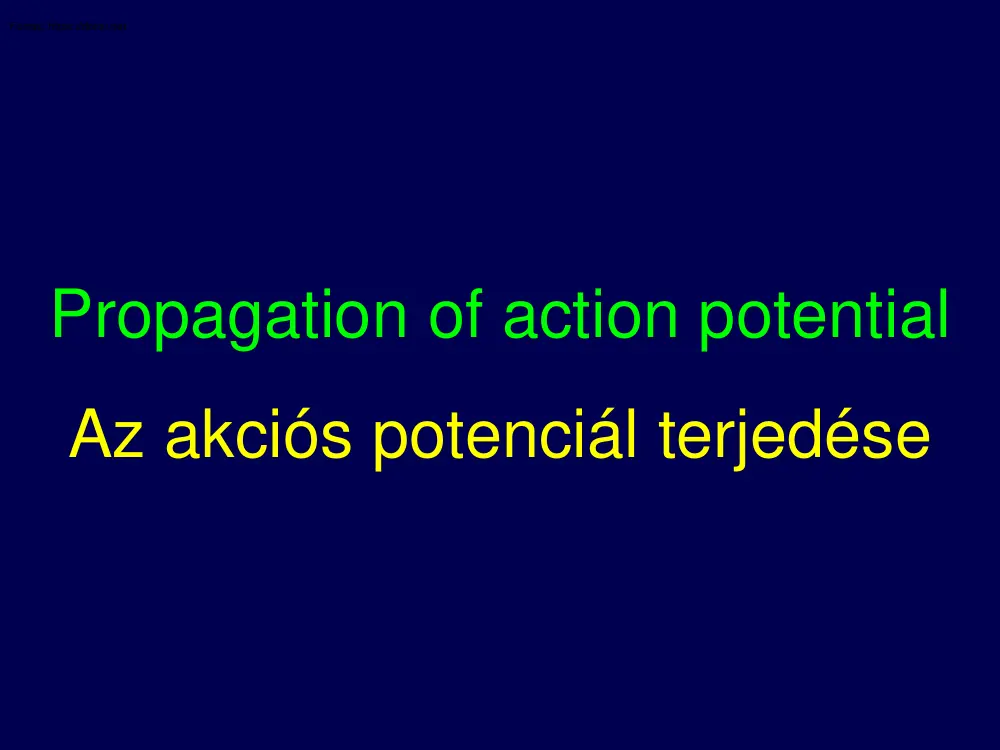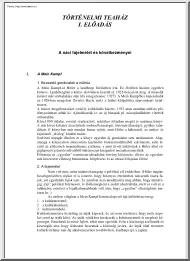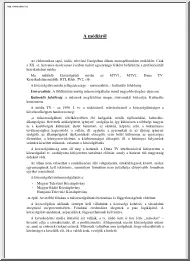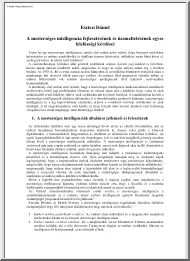Comments
No comments yet. You can be the first!
What did others read after this?
Content extract
Propagation of action potential Az akciós potenciál terjedése Action Potential Propagation Signal spread WITH Na+ channels = “Leak” K channels = Na channels + + + + + + + + + + + − − − +− − − −+− − − − − − − − − − − − + + + + + Brain Vm : -70 mV + + + + + + + + + + + + + + + + + + + Muscle Continuous and Saltatory Propagation of Action Potentials Pulse Propagation in Myelinated and Unmyelinated Nerve Fibers Classification of Nerve Fibers Multiple Sclerosis Multiple sclerosis is a demyelinating disease Strength-duration curve for action potential Minimal stimulation time Intensity of Stimulus (current) Q=IxT 54321- σ Rheobase 0Chronaxie (σ) Duration of stimulus (time) Electrotonic Potential Propagation Signal spread without Na+ channels = “Leak” K channels + + + −+ − − − − − − − − − − − − − − − − − − + + To Brain Vm : -70 mV + + + + + + + + + + + + + + + + + + +
+ To Muscle The Electrotonic Potential • is a transient reversal of the polarity of the membrane potential • does not involve opening of Na+ channels • has no overshoot and involves decrement • travels in both directions ELECTROTONIC COND. ACTION POT. Channels involved K K, Na Action potential? No Yes Decrement Yes No Refractoriness No Yes Summation Yes No Unidirectional No Yes Az akcióspotenciál keletkezése a neuronban Generation of action potential in the neuron A gerincvelői motoneuron The spinal motor neuron Szinaptikus transzmisszió Synaptic transmission Chemical Synapse Termination of Transmitter Action Klasszikus neurotranszmitterek: a szinaptikus végződésben termelődnek Classical neurotransmitters: produced in the synaptic terminal Neurotransmitters in CNS Gátló és serkentő neurotranszmitterek Inhibitory and excitatory neurotransmitters Electrical synapse •Rapid •Few CNS neurons, glia
•Cardiac muscle •Smooth muscle At gap junctions, ions and small molecules pass through connexon channels formed by connexins. In some electrical synapses, the synapse conducts more in one direction than in the opposite; this is called rectification. Electrophysiology of synaptic transmission Arriving AP(s) (1) Depolarize the presynaptic terminal and (2) Trigger Ica through voltagesensitive Ca2+ channels, which causes transmitter release (3) Transmitter binding to the postsynaptic receptors triggers a PSP, in this example an EPSP, that in VM = -70 mV this case is large enough to 2 Pre(4) Trigger a postsynaptic AP synaptic Ica VM = +20 mV 4 Post-synaptic AP 1 Pre-synaptic AP 3 Post-synaptic EPSP (or IPSP) 0.5 msec Electrophysiology of synaptic transmission Synaptic delay is time between onset of the pre- and postsynaptic potentials - For ionotropic receptormediated PSPs, delay is ≥ 0.3 msec, usually 1–5 msec, mostly due to slow, presynaptic Ca2+ influx -
Longer delay for indirect gating, due to additional steps VM = -70 mV (i.e, effector enzymes) - Negligible delay for electrical 2 Presynapses (but no complex synaptic Ica summation can occur) VM = +20 mV 4 Post-synaptic AP 1 Pre-synaptic AP 3 Post-synaptic EPSP (or IPSP) 0.5 msec Synaptic transmission is amplitude modulated, beginning with graded Ca2+ influx PSP amplitude is proportional to presynaptic Ica PSP amplitude is determined by channel conductance (rate of ionic flux) EPSP and by driving force (IEPSP = gEPSP [VM - EEPSP]) Presynaptic ICa Presynaptic Vhold How PSP amplitude depends on presynaptic depolarization and Ca2+ influx. A presynaptic terminal is clamped at a range of depolarizing potentials (Vhold). At each potential, the clamp electrode records the presynaptic Ica and a second electrode records the resulting EPSP. Postsynaptic Potentials • Em changes dendrites & soma • Excitatory: + • Inhibitory: - Record here EPSP + + Em - 65 mv
- 70 mv • Depolarization more likely to fire AT REST Time Temporal Summation + Em + • Repeated stimulation • same synapse - 65 mv - 70 mv AT REST Time Temporal Summation + + more depolarization Em - 65 mv - 70mv AT REST Time Temporal Summation + + more depolarization Em - 65 mv - 70 mv AT REST Time Temporal Summation Spatial Summation + + Em + • Multiple synapses - 65mv - 70mv AT REST Time Spatial Summation IPSPs • Inhibitory Postsynaptic Potential • similar to EPSPs EXCEPT opposite • hyperpolarization (-) – Em becomes more negative • Cl- influx or K+ efflux IPSP + Em • Hyperpolarization less likely to fire also summate (max) - 70mv AT REST Time Effect of IPSP on Postsynaptic Stimulation EPSPs & IPSPs summate • CANCEL EACH OTHER • Net stimulation – EPSPs + IPSPs = net effects + + - 70mv - EPSP IPSP EPSP IPSP threshold -70mV toward threshold away from threshold EPSP
IPSP Effect Excitation Inhibition (or blockade of excitation) Change in potential Depolarization Hyperpolarization (or inhibition of depolarization) Mechanism Opening of Na channels Opening of K or Cl channels Example(s) Nicotinic Ach receptor, NMDA receptor GABA-A, GABA-B receptor, Glycine receptor Summation Yes Yes Characteristic features of an excitatory synapse - A specific excitatory neurotransmitter is released from the presynaptic terminal via EXOCYTOSIS to initiate the excitatory postsynaptic response. - A specific excitatory postsynaptic receptor is necessary to initiate the excitatory postsynaptic response - Extracellular Ca2+ is ALWAYS necessary in the synaptic cleft to release neurotransmitter. This calcium release is usually elicited by DEPOLARIZATION of the presynaptic membrane. - A presynaptic action potential does not always initiate a postsynaptic action potential: summation may be needed. - In the absence of inhibitory input the excitatory
neurotransmitter released always generates a local transient, non-propagated postsynaptic depolarization involving an increase in gNa Presynaptic Modulation • Modifying PSP by influencing presynaptic neuron • Presynaptic inhibition ↓ amount of NT released • Presynaptic facilitation amount of NT released Presynaptic Inhibition Excitatory Synapse A + • A active • B more likely to fire B Presynaptic Inhibition Excitatory Synapse A - + C • axoaxonic synapse • C is inhibitory B Presynaptic Inhibition Excitatory Synapse A - + C • C active • less NT from A • B less likely to fire B Presynaptic Inhibition Inhibitory Synapse A - - C • C active • less NT from A • B more likely to fire B Presynaptic Facilitation Excitatory Synapse A + + C • C active (excitatory) • more NT from A • B more likely to fire B A Facilitáció jelensége The phenomenon of Facilitation Amikor egy idegsejten EPSPk szummálódnak,
amelyek nem elegendőek egy AP kiváltására, de megkönnyítik a következő EPSPk számára az AP kiváltását. („Facilitált neuron”) When EPSPs collect on a neuron, which are not quite sufficient to induce an AP, but make it easier for subsequent EPSPs to induce an AP. (“Facilitated neuron”) 1. 2. 3. 4. 5. 6. 7. A klasszikus neurotranszmitterek a szinaptikus vezikulumokban termelődnek és tárolódnak (kivétel: neuropeptidek: a neuron testében termelődik és axonális transzporttal jut le a szinapszishoz. Akciós potenciál érkezik a preszinaptikus végzôdéshez Feszültségfüggő Ca2+ csatornák nyílnak. Az IC Ca2+ emelkedése a szinaptikus vezikulumok és a szinapszis membrán fúzióját triggereli (exocitózis). A traszmitter (ACh) átdiffundál a szinaptikus résben és elérik a posztszinaptikus membrán nikotinos ACh receptorait. A posztszinaptikus sejt aktiválódik: depolarizáció és izomkontrakció A neurotranszmitter lebomlik és/vagy újra
felvevődik. Kolinerg neuro-transzmisszió Cholinergic neurotransmission Adrenergic Synapses The neuromuscular transmission Neuromuszkuláris transzmisszió A neuromuszkuláris junkció The neuromuscular junction Neuromuscular Transmission Axon Axon Terminal Skeletal Muscle Depolarization Nerve action of terminal opens Cainvades channels + potential axon terminal + - - + + ++ Look - + here + - Neuromuscular Transmission: -+ Step by Step - + + -+ - Binding ofreleased ACh opens Ca+2binds induces fusion ACh to its ACh is and of channel pore that is vesicles with receptor on the nerve diffuses across + and K+. permeable to Na terminal membrane. postsynaptic membrane synaptic cleft. ACh ACh ACh Ca+2 Ca+2 Na+ Na+ Na+ K+ Na+ K+ Na+ K+ ACh Na+ K+ Na+ Na+ Na+ K+ Outside Muscle membrane Na+ K+ Na+ K+ Na+ K+ Inside K+ Na+ K+ K+ K+ K+ Na+ End Plate Potential (EPP) Presynaptic terminal VNa Muscle Membrane Voltage (mV) The
movement of Na+ and K+ depolarizes muscle membrane potential (EPP) 0 EPP Threshold -90 mV VK Presynaptic AP Time (msec) Outside Muscle membrane Inside ACh Receptor Channels Na Channels ACh Choline ACh ACh Meanwhile . ACh isthe by Choline Choline ishydrolyzed taken upfrom ACh unbinds soresynthesized channel closes AChE into Choline into ACh and repackaged into nerve terminal its receptor Choline acetate into and vesicle ACh Acetate ACh Outside Muscle membrane Inside A szinaptikus áttevődés folyamata a neuromuszkuláris junkcióban Summary of events that occur during neuromuscular transmission Neuromuscular Transmission • Properties of neuromuscular junction designed to assure that every presynaptic action potential results in a postsynaptic one (i.e 1:1 transmission) • The NMJ is a site of considerable clinical importance Pharmacology of the NMJ
+ To Muscle The Electrotonic Potential • is a transient reversal of the polarity of the membrane potential • does not involve opening of Na+ channels • has no overshoot and involves decrement • travels in both directions ELECTROTONIC COND. ACTION POT. Channels involved K K, Na Action potential? No Yes Decrement Yes No Refractoriness No Yes Summation Yes No Unidirectional No Yes Az akcióspotenciál keletkezése a neuronban Generation of action potential in the neuron A gerincvelői motoneuron The spinal motor neuron Szinaptikus transzmisszió Synaptic transmission Chemical Synapse Termination of Transmitter Action Klasszikus neurotranszmitterek: a szinaptikus végződésben termelődnek Classical neurotransmitters: produced in the synaptic terminal Neurotransmitters in CNS Gátló és serkentő neurotranszmitterek Inhibitory and excitatory neurotransmitters Electrical synapse •Rapid •Few CNS neurons, glia
•Cardiac muscle •Smooth muscle At gap junctions, ions and small molecules pass through connexon channels formed by connexins. In some electrical synapses, the synapse conducts more in one direction than in the opposite; this is called rectification. Electrophysiology of synaptic transmission Arriving AP(s) (1) Depolarize the presynaptic terminal and (2) Trigger Ica through voltagesensitive Ca2+ channels, which causes transmitter release (3) Transmitter binding to the postsynaptic receptors triggers a PSP, in this example an EPSP, that in VM = -70 mV this case is large enough to 2 Pre(4) Trigger a postsynaptic AP synaptic Ica VM = +20 mV 4 Post-synaptic AP 1 Pre-synaptic AP 3 Post-synaptic EPSP (or IPSP) 0.5 msec Electrophysiology of synaptic transmission Synaptic delay is time between onset of the pre- and postsynaptic potentials - For ionotropic receptormediated PSPs, delay is ≥ 0.3 msec, usually 1–5 msec, mostly due to slow, presynaptic Ca2+ influx -
Longer delay for indirect gating, due to additional steps VM = -70 mV (i.e, effector enzymes) - Negligible delay for electrical 2 Presynapses (but no complex synaptic Ica summation can occur) VM = +20 mV 4 Post-synaptic AP 1 Pre-synaptic AP 3 Post-synaptic EPSP (or IPSP) 0.5 msec Synaptic transmission is amplitude modulated, beginning with graded Ca2+ influx PSP amplitude is proportional to presynaptic Ica PSP amplitude is determined by channel conductance (rate of ionic flux) EPSP and by driving force (IEPSP = gEPSP [VM - EEPSP]) Presynaptic ICa Presynaptic Vhold How PSP amplitude depends on presynaptic depolarization and Ca2+ influx. A presynaptic terminal is clamped at a range of depolarizing potentials (Vhold). At each potential, the clamp electrode records the presynaptic Ica and a second electrode records the resulting EPSP. Postsynaptic Potentials • Em changes dendrites & soma • Excitatory: + • Inhibitory: - Record here EPSP + + Em - 65 mv
- 70 mv • Depolarization more likely to fire AT REST Time Temporal Summation + Em + • Repeated stimulation • same synapse - 65 mv - 70 mv AT REST Time Temporal Summation + + more depolarization Em - 65 mv - 70mv AT REST Time Temporal Summation + + more depolarization Em - 65 mv - 70 mv AT REST Time Temporal Summation Spatial Summation + + Em + • Multiple synapses - 65mv - 70mv AT REST Time Spatial Summation IPSPs • Inhibitory Postsynaptic Potential • similar to EPSPs EXCEPT opposite • hyperpolarization (-) – Em becomes more negative • Cl- influx or K+ efflux IPSP + Em • Hyperpolarization less likely to fire also summate (max) - 70mv AT REST Time Effect of IPSP on Postsynaptic Stimulation EPSPs & IPSPs summate • CANCEL EACH OTHER • Net stimulation – EPSPs + IPSPs = net effects + + - 70mv - EPSP IPSP EPSP IPSP threshold -70mV toward threshold away from threshold EPSP
IPSP Effect Excitation Inhibition (or blockade of excitation) Change in potential Depolarization Hyperpolarization (or inhibition of depolarization) Mechanism Opening of Na channels Opening of K or Cl channels Example(s) Nicotinic Ach receptor, NMDA receptor GABA-A, GABA-B receptor, Glycine receptor Summation Yes Yes Characteristic features of an excitatory synapse - A specific excitatory neurotransmitter is released from the presynaptic terminal via EXOCYTOSIS to initiate the excitatory postsynaptic response. - A specific excitatory postsynaptic receptor is necessary to initiate the excitatory postsynaptic response - Extracellular Ca2+ is ALWAYS necessary in the synaptic cleft to release neurotransmitter. This calcium release is usually elicited by DEPOLARIZATION of the presynaptic membrane. - A presynaptic action potential does not always initiate a postsynaptic action potential: summation may be needed. - In the absence of inhibitory input the excitatory
neurotransmitter released always generates a local transient, non-propagated postsynaptic depolarization involving an increase in gNa Presynaptic Modulation • Modifying PSP by influencing presynaptic neuron • Presynaptic inhibition ↓ amount of NT released • Presynaptic facilitation amount of NT released Presynaptic Inhibition Excitatory Synapse A + • A active • B more likely to fire B Presynaptic Inhibition Excitatory Synapse A - + C • axoaxonic synapse • C is inhibitory B Presynaptic Inhibition Excitatory Synapse A - + C • C active • less NT from A • B less likely to fire B Presynaptic Inhibition Inhibitory Synapse A - - C • C active • less NT from A • B more likely to fire B Presynaptic Facilitation Excitatory Synapse A + + C • C active (excitatory) • more NT from A • B more likely to fire B A Facilitáció jelensége The phenomenon of Facilitation Amikor egy idegsejten EPSPk szummálódnak,
amelyek nem elegendőek egy AP kiváltására, de megkönnyítik a következő EPSPk számára az AP kiváltását. („Facilitált neuron”) When EPSPs collect on a neuron, which are not quite sufficient to induce an AP, but make it easier for subsequent EPSPs to induce an AP. (“Facilitated neuron”) 1. 2. 3. 4. 5. 6. 7. A klasszikus neurotranszmitterek a szinaptikus vezikulumokban termelődnek és tárolódnak (kivétel: neuropeptidek: a neuron testében termelődik és axonális transzporttal jut le a szinapszishoz. Akciós potenciál érkezik a preszinaptikus végzôdéshez Feszültségfüggő Ca2+ csatornák nyílnak. Az IC Ca2+ emelkedése a szinaptikus vezikulumok és a szinapszis membrán fúzióját triggereli (exocitózis). A traszmitter (ACh) átdiffundál a szinaptikus résben és elérik a posztszinaptikus membrán nikotinos ACh receptorait. A posztszinaptikus sejt aktiválódik: depolarizáció és izomkontrakció A neurotranszmitter lebomlik és/vagy újra
felvevődik. Kolinerg neuro-transzmisszió Cholinergic neurotransmission Adrenergic Synapses The neuromuscular transmission Neuromuszkuláris transzmisszió A neuromuszkuláris junkció The neuromuscular junction Neuromuscular Transmission Axon Axon Terminal Skeletal Muscle Depolarization Nerve action of terminal opens Cainvades channels + potential axon terminal + - - + + ++ Look - + here + - Neuromuscular Transmission: -+ Step by Step - + + -+ - Binding ofreleased ACh opens Ca+2binds induces fusion ACh to its ACh is and of channel pore that is vesicles with receptor on the nerve diffuses across + and K+. permeable to Na terminal membrane. postsynaptic membrane synaptic cleft. ACh ACh ACh Ca+2 Ca+2 Na+ Na+ Na+ K+ Na+ K+ Na+ K+ ACh Na+ K+ Na+ Na+ Na+ K+ Outside Muscle membrane Na+ K+ Na+ K+ Na+ K+ Inside K+ Na+ K+ K+ K+ K+ Na+ End Plate Potential (EPP) Presynaptic terminal VNa Muscle Membrane Voltage (mV) The
movement of Na+ and K+ depolarizes muscle membrane potential (EPP) 0 EPP Threshold -90 mV VK Presynaptic AP Time (msec) Outside Muscle membrane Inside ACh Receptor Channels Na Channels ACh Choline ACh ACh Meanwhile . ACh isthe by Choline Choline ishydrolyzed taken upfrom ACh unbinds soresynthesized channel closes AChE into Choline into ACh and repackaged into nerve terminal its receptor Choline acetate into and vesicle ACh Acetate ACh Outside Muscle membrane Inside A szinaptikus áttevődés folyamata a neuromuszkuláris junkcióban Summary of events that occur during neuromuscular transmission Neuromuscular Transmission • Properties of neuromuscular junction designed to assure that every presynaptic action potential results in a postsynaptic one (i.e 1:1 transmission) • The NMJ is a site of considerable clinical importance Pharmacology of the NMJ





 Just like you draw up a plan when you’re going to war, building a house, or even going on vacation, you need to draw up a plan for your business. This tutorial will help you to clearly see where you are and make it possible to understand where you’re going.
Just like you draw up a plan when you’re going to war, building a house, or even going on vacation, you need to draw up a plan for your business. This tutorial will help you to clearly see where you are and make it possible to understand where you’re going.